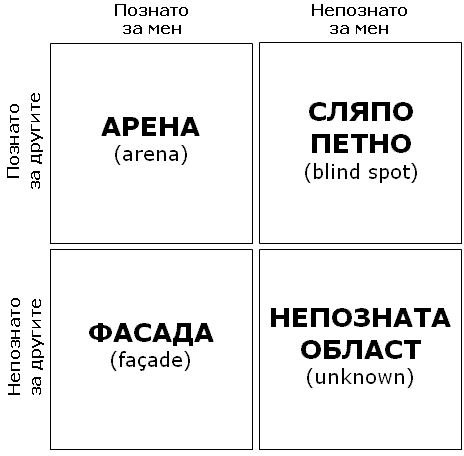An Overview of the Johari Window Model and How It Helps Project Teams
The word “Johari” derives from the name of its proponents, Joseph Luft “Jo” and Harry Ingham “Hari.” These psychologists devised the Johari window theory as a foursquare grid for each person that aims to map the person characteristics, and advocate the use of disclosure, and feedback to improve the grid. The objective of the Johari window model is to promote better understanding of the each individual in a group context.
Image Credit: Wikimedia Commons
The Window
The Johari window model assigns a grid or “window” to each individual, with the four quadrants in the grid representing Open Area, Blind Spot, Hidden Area, and Unknown Area
- Arena or Open Area: This quadrant represents public information about the person, known by each individual and others. This usually includes qualifications, achievements, experience, dominant personality traits, key skills such as good communication skills, and other traits.
- Blind Spot or Blind Area: This quadrant refers to the characteristics of the person unknown to the individual themselves, but known to others. For instance, individuals do not comprehend that their behaviors may be a deep rooted manifestation of feelings of incompetence, unworthiness, or rejection, and it usually takes a psychologist to bring these traits to the open. Similarly, a person may be unaware of innate talents and it might take an observant coach or mentor to bring the talent out in the open.
- Facade or Hidden Area: This quadrant represents the secret side of the person, or what the person knows and others do not know, the individual keeping such information concealed deliberately or otherwise. Individuals in groups might fail to reveal their perceptions, opinions, or viewpoints to others owing to fear of reprisal or going against group norms, or might want to keep some skills hidden for use as an element of surprise at an opportune time.
- Unknown Area: This quadrant represents the characteristics innate in a person, but which neither the person nor anyone else comes to realize. People with unfulfilled talent and potential, usually have many interpersonal dynamics and resources in this unknown area.
Application
The purpose of the Johari window concept is to expand the open area of an individual through self-disclosure and feedback. Self disclose by the person expands the open area horizontally by contracting the facade or hidden area. Feedback from others expands the open area vertically by contracting the unknown area.
A new member in a team setting will invariably have a small arena and blind spot, and a large facade. As the member progresses in the team, others would get to know about their innate characteristics and traits, and pass it on to the team member as feedback, allowing him or her to increase arena at the cost of a blind spot. The member, as they work with others, reveals more about themselves as disclosure, again increasing the arena at the expense of the facade.
The disclosure and feedback in Johari windows is structured, and is through adjectives such as “able,” “adaptable,” “calm,” “friendly,” “independent,” “ingenious,” “knowledgeable,” “nervous,” “organized,” “patient,” “reflective,” “religious,” “assertive,” “self-conscious,” “sensible,” “trustworthy,” and others.
Uses
What does a large arena in the Johari window mean? The Johari window promotes teamwork and group communication.
Analyzing the Johari window model, expansion of the arena or open area by sharing information, builds trust and promotes interpersonal relationships in a group and team setting. A large arena allows people to communicate and cooperate with the person free from ambiguity and misunderstanding. Other team members can understand the person’s action and words without having to make perceptive interpretation on behavior.
The expansion of the arena helps in identifying individual competence, priorities and perspective, applications of strengths and elimination of weakness, and identification of suitable interventions such as training and job redesign to reconcile individual expectations and priorities with group expectations and priorities.
The Johari window model also finds use to communicate with team members appropriately. For instance, adjusting our level of openness to match the level of openness displayed by another person help us strike up a rapport with that person.
